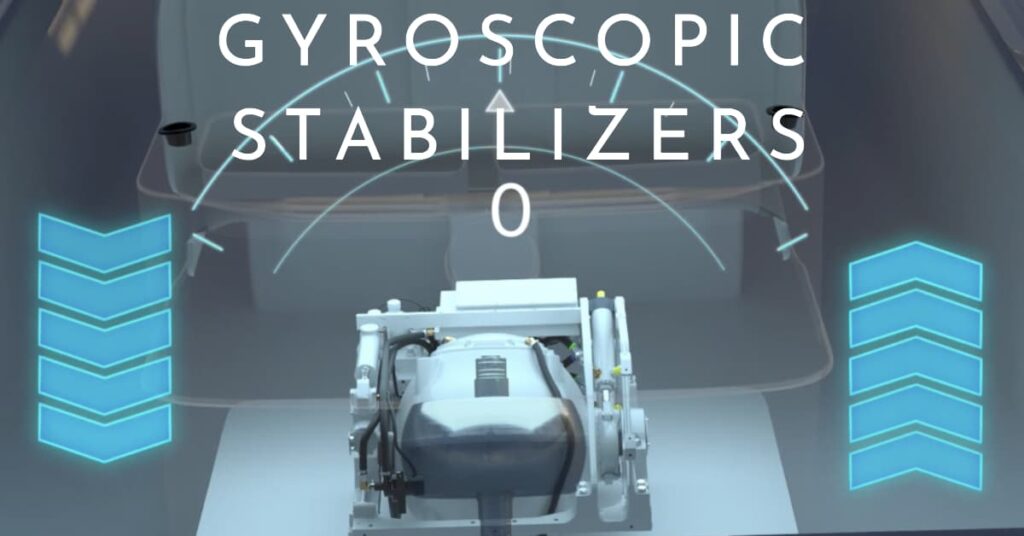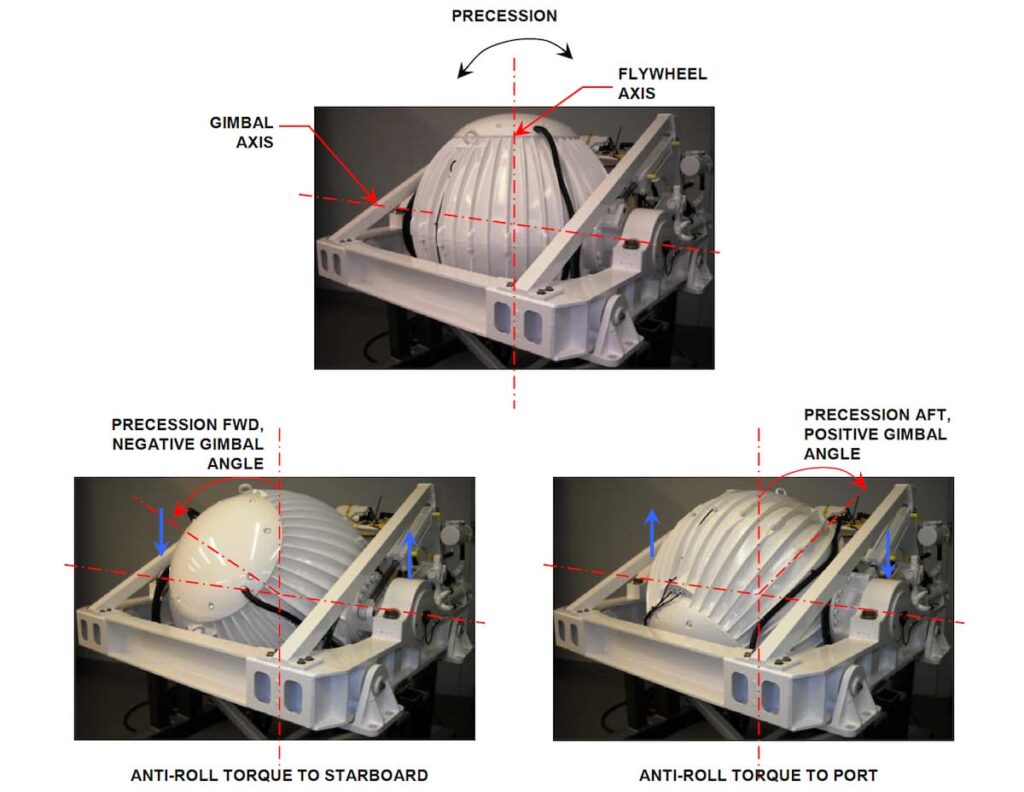Have you ever sipped a glass of wine on a boat, only to have the vessel’s rocking toss your drink? Enter gyroscopic stabilizers – the marvel of maritime technology that promises to make those unexpected spills a thing of the past.
Offering stability in the midst of undulating waves, these high-tech gadgets are transforming our experience at sea. Intrigued? Let’s delve into the fascinating world of gyroscopic stabilizers.

Unraveling the Mechanics: How Gyroscopic Stabilizers Work
If you’ve ever ridden a bicycle, you’re already acquainted with the principles of a gyroscope. As you cycle faster, you’ll find it easier to maintain balance. This balance is provided by the gyroscopic effect.

A gyroscopic stabilizer uses a similar concept. Hidden inside a sealed case, a large flywheel spins at extremely high speeds, creating the gyroscopic effect. When waves hit the boat, they tend to induce roll, which the gyroscope resists, thus reducing the boat’s rolling motion. It’s science at its best – using physics to keep your drink from spilling!
A Revolution at Sea: Advantages of Gyroscopic Stabilizers
Gyroscopic stabilizers are all about enhancing comfort and safety. When your boat starts to rock in choppy water, a gyro stabilizer gets to work, providing a smoother, more enjoyable ride. It’s like an invisible hand, steadying your boat, and offering an enhanced seafaring experience.
These stabilizers aren’t just for the high seas, though. They perform equally well at zero speed, while you’re anchored, ensuring your afternoon nap on the deck isn’t disturbed by the roll of the waves.
| Key Aspect | Description |
|---|---|
| Function | Reduces boat roll, enhances stability |
| How it Works | Utilizes high-speed spinning flywheel to create a gyroscopic effect |
| Benefits | Improved comfort at sea, reduced seasickness, stability at zero speed |
| Drawbacks | High initial cost, ongoing maintenance, power consumption |
| Costs | Ranges from $10,000 to over $350,000, depending on vessel size |
| Examples of Use | Large yachts, fishing vessels, leisure boats |
Considering the Flipside: Disadvantages of Gyroscopic Stabilizers
Like any technology, gyroscopic stabilizers aren’t without their drawbacks. While they do an excellent job at reducing roll, they aren’t designed to prevent pitch (the front-to-back rocking).
Moreover, the machinery involves high-speed rotating parts, which can wear out over time, leading to maintenance costs. Finally, the system consumes considerable power, which could be a downside for boats with limited generator capacity.
Investing in a gyroscopic stabilizer is not a small expense. The initial purchase can range anywhere from $10,000 to over $350,000, depending on the size of your vessel. The ongoing maintenance costs can also add up. However, for many boaters, the added comfort and stability are worth the expense.
Gyroscopic Stabilizers in Action
To better understand how this technology works, let’s look at a real-life example.
| Application | Description |
|---|---|
| Large Yachts | Large yachts and super yachts often have multiple gyro stabilizers installed. These systems are often integrated into the ship’s design during construction. |
| Fishing Vessels | Professional fishing boats use gyro stabilizers to ensure a stable platform when casting nets or lines. A steady boat is crucial for accurate casting and a safe working environment. |
| Leisure Boats | Private boat owners are increasingly adopting gyro stabilizers for a more comfortable boating experience. This is especially useful for people who are prone to seasickness. |
As you can see, gyroscopic stabilizers are making waves across different types of boats. Whether you’re a seasoned sailor, an angler, or a casual boater, there’s no denying the appeal of a smoother, more stable ride. While the costs and maintenance can be significant, many believe it’s a worthy investment for the enhanced comfort and stability it brings.
With technological advancements, we can only expect gyroscopic stabilizers to become more efficient and more accessible in the future.
Gyroscopic Stabilizers On Cruise Ships
Cruise ships, the Titans of the Sea, present a unique challenge when it comes to stabilization. They are often subject to significant rolling motions due to their large size and the vast open waters they traverse. So, does the technology of gyroscopic stabilizers find its application on these large vessels?
To answer simply, yes, cruise ships often use stabilization systems. However, the technology used is typically not the same as the gyroscopic stabilizers found on smaller boats and yachts. Cruise ships commonly use a different type of stabilizer, known as fin stabilizer.
Fin stabilizers are large fins or wings that extend out from the side of the ship, beneath the waterline. These fins are designed to counteract the rolling motion caused by waves. They adjust their angle based on the movement of the ship, creating a force that reduces roll.
The reason why gyroscopic stabilizers aren’t typically used on large vessels like cruise ships lies in the scale of the problem. Cruise ships are so much larger and heavier than yachts and fishing boats that a gyroscopic stabilizer large enough to effectively reduce roll would be impractical and costly. Fin stabilizers, on the other hand, can be scaled up more effectively for larger vessels, making them the preferred solution for these giant ships.
However, with the constant advancement in technology, the future may hold a place for gyroscopic stabilizers in larger vessels. The boating world is ever-evolving, and with the continued refinement and development of stabilization technology, it’s possible that one day we might see gyroscopic stabilizers as a common feature on our favorite cruise ships.
The Largest Gyroscopic Stabilizers
When it comes to the world of gyroscopic stabilizers, size and performance often go hand-in-hand. These marvels of engineering are specifically tailored to work in sync with the size of the vessels they are meant to stabilize.
A significant milestone in this field has been the unveiling of the VG1000SD by VEEM. As per the latest updates, this powerhouse has claimed the title of being the world’s largest gyroscopic stabilizer.
Designed to provide exceptional roll reduction for vessels upwards of 75 meters in length, the VG1000SD offers a massive angular momentum output of 1000 kNm-s. With such impressive specs, it sets a new standard in the world of marine stabilization.
VEEM’s achievement shows how rapidly the field is advancing, with larger and more powerful stabilizers being developed to cater to an extensive range of maritime needs. As technology continues to evolve, the application of gyroscopic stabilizers in larger vessels, such as mega yachts and potentially even cruise ships, becomes increasingly plausible.
However, it’s crucial to stay updated with the latest advancements in this ever-evolving field. Technology moves quickly, and today’s record-breaker might be tomorrow’s norm. Always consult with industry professionals to ensure you’re getting the most current and accurate information.
Here are the largest gyroscopic stabilizers on the market:
- VG1000SD: The VG1000SD is the world’s largest and most powerful gyrostabilizer, weighing 20 metric tonnes and generating 1000kN.m. It has been designed to stabilize large vessels, particularly commercial, defense vessels, and luxury mega-yachts that do not have a current gyro stabilizing option1.
- M21000: The M21000 is the largest gyro stabilizer in the Seakeeper range and is more commonly seen in commercial vessels. It recently debuted at Sanctuary Cove.
- 375T: The 375T is the largest and most impressive unit from a manufacturer of gyroscopic stabilizers. It has an impressive 37,500Nms of reliable Anti Rolling Torque.
Tackling the Technical Aspects: Installation and Maintenance of Gyroscopic Stabilizers
The installation of a gyroscopic stabilizer isn’t a DIY job; it requires professional assistance due to the complexities involved. The unit needs to be securely bolted into the boat’s hull, often below deck level to keep the center of gravity low.
Once installed, regular maintenance is key to keep the system performing at its peak. This typically involves periodic inspections to ensure all parts are working correctly, as well as replacing any worn-out components.
Embracing Innovation: The Future of Gyroscopic Stabilizers
It’s clear that gyroscopic stabilizers are transforming the maritime world, offering a solution to the age-old problem of boat stability. As this technology continues to evolve, we can expect to see even more impressive advancements.
One such development is the integration of AI technology into gyroscopic stabilizers. By harnessing AI, these systems can anticipate wave patterns and respond proactively, offering an even smoother ride. Moreover, this integration could also improve the longevity of the system, by optimizing its performance and reducing wear on parts.
Weighing it All Up: Are Gyroscopic Stabilizers Worth it?
When deciding if a gyroscopic stabilizer is right for you, it’s important to consider both the costs and benefits. On the one hand, you have the initial cost of the unit, the cost of installation, and ongoing maintenance expenses. On the other hand, you have the promise of a smoother, more enjoyable boating experience, which can be particularly valuable for those who suffer from seasickness.
In the end, the decision will depend largely on your specific needs, your budget, and how much you value a stable ride. There’s no one-size-fits-all answer, but one thing’s for sure: once you’ve experienced the stability that a gyroscopic stabilizer can provide, it’s hard to go back.
In Conclusion: Harnessing the Power of Physics for a Smoother Sail
Gyroscopic stabilizers are no longer a fringe technology used by a select few. They’re making their way into mainstream maritime use, from professional fishing vessels to luxury yachts and leisure boats.
By harnessing the principles of physics, these stabilizers promise to enhance our experience on the water, providing a level of comfort and stability that was previously unattainable. Sure, they come with a price tag and need careful maintenance, but for many, the benefits far outweigh these considerations.
So, whether you’re a seasoned sailor, a weekend boater, or someone who simply enjoys the thrill of the open water, the power of gyroscopic stabilizers is within your reach. It’s time to set sail and embrace the smoother, more enjoyable journey that awaits.
- Types of Gas Carriers as per IGC Code – April 22, 2025
- Wind-Assisted Propulsion Systems (WAPS): A Game Changer for Maritime Decarbonization – February 6, 2025
- 10 Boat Salvage Yards in California – January 25, 2025





